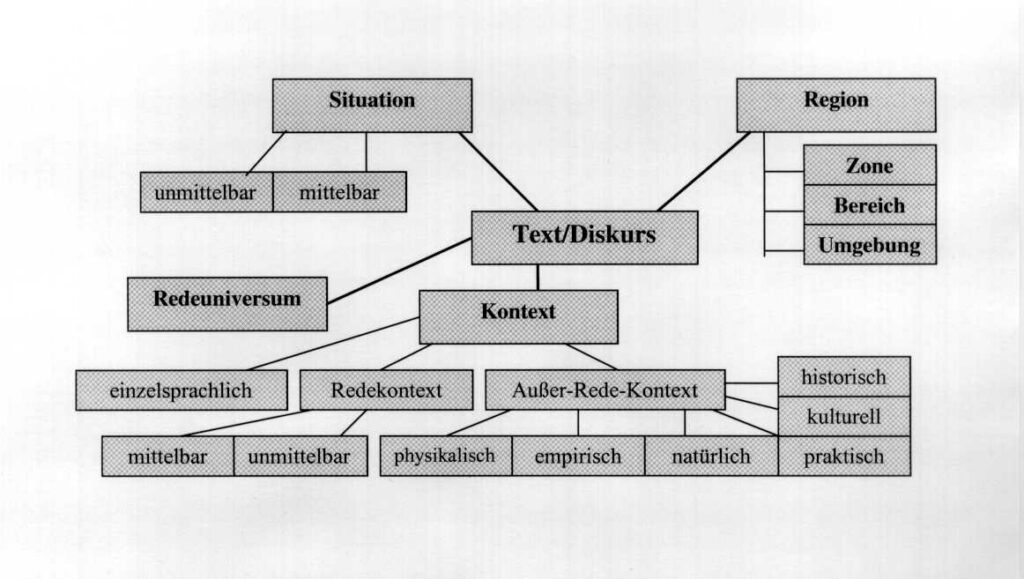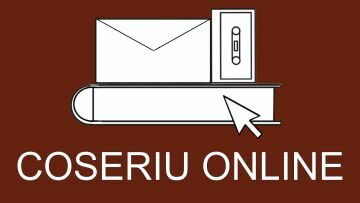Determination and surrounding fields
In 1955/56, the essay “Determinación y entorno”, an extract from the unpublished book Teoría lingüística del nombre propio, was published in the review Romanistisches Jahrbuch. It outlines a linguistic theory of speech which starts by reversing Saussure’s rule that all linguistic questions must proceed from the point of view of the langue. Coseriu maintains that all questions must rather proceed from speech: “rather than on the foundation of langue ‘one must stand from the beginning on the foundation of speech and make this the norm for all other linguistic issues’ (including langue).
The essay then presents a compressed description of a linguistic theory of speech and a first outline of a theory of text linguistics. Here Coseriu deals with the issue of determination, especially with regard to the question of nominal determination and proper names. Besides the classification of linguistic possibilities of determination, a precise representation of linguistic surrounding fields (“Umfelder” in Bühler’s sense) is also given.
Coseriu distinguishes between various operations of determination (of nouns in particular) which “actualize” a virtual linguistic sign: actualization, discrimination, delimitation and identification.
Actualization directs a virtual sign to an object and transfers “identity” (e.g. “person”) to “ipsity” (e.g. “the person”).
Discrimination is what Coseriu calls all operations that go beyond actualization; they direct the denotation to “a possible or actual group of single entities”. Discrimination has three subgroups: quantification, selection and situation, with their corresponding operations. Quantification refers to the countability of the designated objects. Selection denotes the specificity of the objects: while quantification only distinguishes a “quantity/group” from something (e.g. “I’m looking for an apartment”), selection deals with particular or individual objects (“I’m looking for an apartment I read about”; “I’m looking for my brother’s apartment). Situation finally connects the designated objects with persons via possessive determiners (“your apartment”) or with space and time via deictic determiners (“this apartment”).
Delimitation, according to Coseriu, is opposite to discrimination, which specifies objects of reference with unchanging possible designation. Delimitation denotes various ways to limit a sign’s possible designation. Here there are also three subgroups: explication, specialization and specification. Explication underlines certain characteristics of the designated object without changing it (“the vast ocean”). In specialization, specific external or internal boundaries of the designated object are drawn (“the entire human being”; “Goethe as a poet”). Finally, specification “limits the possible reference of a sign” by adding characteristics that are not contained in the general meaning (“the blonde boy”, “the water birds”).
Identification deals with specifying the meaning of an ambiguous form, such as “soccer team”, “New York”, “Córdoba, Argentina”.
The various operations of determination serve to direct linguistic signs to objects. But for linguistic communication, an array of other relationships are relevant, which one can describe as what Coseriu calls surroundings.
Traditionally, language and context are distinguished; sometimes the latter is defined even more precisely as linguistic and extralinguistic context. The distinction between extralinguistic context and linguistic cotext goes back to J. Catford. A more precise determination is made by Karl Bühler, adopting the term surroundings from the theory of colors. However, Coseriu’s classification of various surroundings is even more detailed. To begin with, he distinguishes between four main fields of surroundings, which are determined firstly by speech and the speaker (“situation”), secondly by the sign and its system of reference (“region”), thirdly by the concrete sign in the text and its vicinity (“context”), and fourthly by a general system of reference (“universe of speech”). He distinguishes between the following surroundings:
a) Situation. This term, which is used in a very differing way in text linguistics and pragmatics, is given a restricted definition by Coseriu: “‘Situation’ denotes only the circumstances and relations in time and space which are caused by the act of speaking itself, by the fact that somebody is speaking to somebody about something at a specific place and at a specific time.” This pertains to the speaker’s origo in Bühler’s sense, to the speaker’s ego-hic-nunc and the resulting constellations.
b) Region. The term “region” pertains to the spaces inside of which a linguistic sign may function, in certain semantic systems. Coseriu distinguishes between the subordinate terms zone, sphere and vicinity. The zone is the space where a sign is known, a question of language boundaries. The sphere is the cultural space where the designated objects are known. Finally, the vicinity is “a socially or culturally determined ‘region’ such as the family, school, professional group or caste”.
c) Context. Coseriu distinguishes between three types of context: the idiomatic context, the verbal context and the extraverbal context. The idiomatic context consists of the signs of the specific language in which the text is written. The verbal context largely corresponds to what is known as cotext, however Coseriu distinguishes between direct and indirect context, i.e. different degrees of distance of text segments. Furthermore, he distinguishes positive and negative verbal context. The latter pertains to unexpressed elements which can be perceived as “missing” because of a disappointed expectation (e.g. because of a certain common tradition). Concerning non-verbal context, Coseriu distinguishes between the physical context, which pertains to things “the sign is inherent to”; the empirical context, i.e. the objects and circumstances “which are known to the interlocutors at the time and place of their communication”; the natural context, which pertains to knowledge of the natural world; the practical or occasional context, which pertains to what may be called the “pragmatic” characteristics of the specific text, i.e. those characteristics which are a result of the communication situation, the relation of text producer and text recipient and the specific occasion of communication. A further extraverbal context is the historical context, which distinguishes between two types of knowledge of the interlocutors: particular knowledge (concerning the history of a smaller community) and universal knowledge (concerning a nation, a larger cultural community or all of humanity as a cultural community). Coseriu also distinguishes between current and non-current historical context; similarly to the situation, which must be divided into direct and indirect situation, the historical reference can be on a non-current level???. Finally, the cultural context is mentioned, which pertains to the known cultural tradition of a community.
d) Universe of speech. The universe of speech is the “system of meaning a text belongs to from which it derives its validity and specific meaning”.
The differentiation is very detailed, so it can be applied to all texts. The surroundings of written texts are reduced: various surroundings are comprised in one or limited in their capacities, e.g. the situation of a written text is determined, whereas the situation is dynamic in a conversation of multiple people. In turn, written texts can create direct situations by linguistic means. Other surroundings which are present in an oral conversation must be converted into language in a written text. Yet if one includes the performance of written texts, the surroundings are again increased: between the written text and the reader, the situation can be doubled.

“Determinación y entorno. Dos problemas de una lingüística del hablar”, Romanistisches Jahrbuch VII, (1955-56) 29–54. German translation: “Determinierung und Umfeld”, in: Eugenio Coseriu, Sprachtheorie und allgemeine Sprachwissenschaft. 5 Studien, München: Fink 1975, 253-290, translated by Uwe Petersen.
